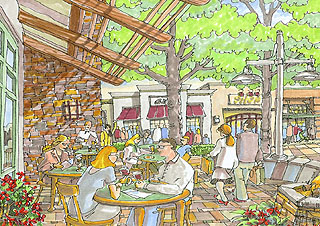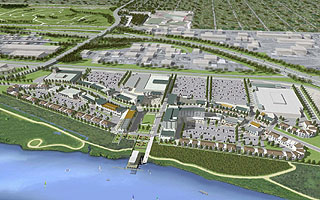
Surveys
DJC.COM
December 7, 2007
Developing retail? Here are some things to know
CBRE

Wilde
|
Is it any wonder that the moniker for every new retail project built in the past decade is “lifestyle”? The reality is that for retail to be successful it must reflect the culture of the neighborhoods it will serve along with the tastes and aspirations of the customers it hopes to attract. This golden rule applies to both retailers and retail developments.
Morphing retailers
Grocery stores have come out of their coma of mediocrity. First they were shaken by the behemoth Wal-Mart, and then alarmed by the savvy Whole Foods — generally losing market share from all sides. Traditional grocery operators are finding their niche between the value-driven approach and the lavish persuasion of Whole Foods.

Image courtesy of CBRE Uptown Gig Harbor, a neighborhood lifestyle project, will connect with a 90,000-square-foot medical lodge being developed by MultiCare. |
Safeway is coming back through remodeling its existing stores with a budget of $1.7 billion for remodels to be completed in 2007. Forty-eight percent of the chain’s 838 stores have undergone major conversions into their lifestyle formats. Similarly, Albertson’s has allocated $1.2 billion to upgrade 100 stores to what it is calling Premium Fresh prototypes.
Selection vs. service
Grocers are not the only retailers battling mega stores for market share. Best Buy has overcome the value approach to retailing by adding services that the busy lifestyles of its customers demand. Offering customer installations of high-tech TVs and other electronics helped it increase sales by 16 percent last year.
PetSmart increases customer visits with services such as grooming, obedience classes and on-site veterinarians. Target is the current darling of the retail world and regarded as one of the favored co-tenants of Nordstrom and the quintessential anchor for every developer. The retailer appeals to affluent customers that appreciate service, well-trained staff and value.
Target, Macy’s and others are using brilliant ads and strategic alignment with popular designers to bridge the generation. This trend will help them compete during the current shift in buying power from baby boomers to the electronic generations.
Housing’s impact

Image courtesy of CBRE Everett Riverfront will have 125 acres of wetlands, along with 50 acres of residential and 50 acres of retail, hospitality, office and entertainment along the Snohomish River. |
The obvious impact of the decline in housing value has already been seen in the declining sales of home furnishings and home improvement stores. The less obvious impact is that on the non-housing retail such as apparel. According to The Puget Sound Economic Forecaster, there is a direct correlation between home value and non-housing retail sales that is roughly .17 percent for every percentage point of depreciation in value.
Strong job growth and increasing personal income in the Puget Sound region will help offset some of the decrease in retail sales through 2008, according to Conway and Pedersen’s report.
Sensitivity is cool
Retailers are realizing the cost savings and cachet that concern for the environment — such as LEED-certified buildings — can bring to the bottom line. Sensitivity does not stop with the environment: No retailer wants the stigma of using child labor or taking advantage of under-compensated locals.
How box retailers are perceived by the neighborhood and city officials also reflects back to a retailer’s bottom line and real estate strategy.
Niche, luxury to expand
Niche retailers catering to the specific taste, demographic profile, income level or aspiration of their customers will continue to grow despite economic slowdowns. Today, with high school girls insisting that Dior is the only mascara to buy and word processors wearing Prada shoes, luxury retailers are spanning all economic strata.
Internet marketing has opened the door for small, startup niche brands and trendy products like no other medium in history. Although the Internet still only accounts for 2.5 percent of all retail sales, it will continue to gain market share as the dot-com generation takes its place as the most influential segment of the consumer pool.
Luxury and premium retail generally skate through economic slowdowns. So far this trend is holding true: Year-to-date sales have increased 7.1 percent for Nordstrom, 4.4 percent for Neiman Marcus and 17 percent for Tiffany’s.
The three R’s
Remodel, reinvent and revitalize have been the dominant trend in retail development for the last five years.
Remodels. Every major enclosed mall in the region has undergone major remodels. The climate-controlled environments and predictable retailer mix of the malls have been losing market share to the new trend of open-air centers. The exodus from the malls in favor of exciting new open-air retail environments closer to the customer was initiated by national boutique retailers. The malls response to this trend is adding open-air lifestyle space on the exterior of the malls known as “villages,” complete with the new, albeit predictable, national boutique retailers.
Reinvention. The reinvention of neighborhood retail centers is the purist form of lifestyle retail development. These new projects are overcoming the predictable retailer mix by adding local boutiques and restaurants. Reinvented neighborhood retail centers are giving local residents a sense of pride and connection with their community because they see their neighbors either running the shop or as customers in the stores.
Lavish landscaping and open public spaces where people can gather without the “buy me” sensory bombardment of the malls is an integral ingredient for lifestyle centers. Distinguished restaurants and new theaters bring the centers to life in the critical evening hours.
Health, wellness and medical-care providers are also joining the party, finding these gathering places a convenient location for patients and popular place for those waiting for their friends or loved ones. Mill Creek Town Center, which combines Central Market and LA Fitness with retail and restaurants is a good operating example of this reinvented neighborhood center. Kent Station brings municipal offices and theater together with the unique retailers and restaurants to populate the new retail neighborhood with people at all hours.
Various local neighborhood lifestyle projects under construction include Uptown Gig Harbor, The High Streets in Issaquah and Sunrise Village in Puyallup.
At Uptown Gig Harbor, MultiCare has built a 90,000-square-foot medical lodge as a part of the development. Architectural features of this cutting-edge facility include a two-story rock fireplace, an open ceiling supported by log beams and extensive use of natural materials to set the stage for a whole new medical experience. Additionally, there is a 10,000-square-foot spa with a variety of luxurious treatment options, similar to what one would find in high-end hotels. The developer and MultiCare are working on a paging program that would allow those waiting for patients to take a paging puck with them while shopping in the nearby Border’s Books, having lunch at one of the various restaurants or watching a movie at the new high-tech Galaxy Theater.
Revitalization. What do baby boomer empty nesters have in common with young professional singles? They both have a desire for urban lifestyles, which is spawning the third retail development trend of revitalization.
Bellevue and Seattle have seen in-city residential populations skyrocket as boomers and young professionals come back for a mixture of culture, dining, entertainment and retail that only a city can offer. Many retailers benefit from this trend, as are developments that include appropriate retail.
With great bones of yesteryear’s architecture, Tacoma and Everett are also being revitalizing. Both cities had declining residential populations, but are turning that trend around by attracting higher education and new residential projects, along with existing office and medical facilities.
Everett’s metamorphosis began when very brave public officials committed funds for their new Events Center and upgraded streetscapes to include public art and pocket parks. Next, they actively pursued new developments along the city’s waterfront and riverfront. The results so far are two major developments: Port Gardner Wharf and Everett Riverfront.
Port Gardner Wharf, under construction along the shores of Puget Sound, will be the second largest marina on the West Coast and the only new marina that can accommodate 50-to-100-foot-long vessels.
Currently on the planning boards is Everett Riverfront, a 225-acre development along the Snohomish River that will include 50 acres of residential and 50 acres of retail, hospitality, office and entertainment. The remaining 125 acres will be revitalized wetlands.
Everett Riverfront will be the only location in the region where all facets of the Northwest can be indulged. Vehicles loaded with canoes, bikes or roller blades will bring visitors to a place where they can recreate along the river, eat lunch, stroll along shop-lined streets, or head to a comfy hotel room for a quick change and go out for dinner and a movie.
Retailers and restaurants will line the new street creating a vibrant, revitalized community.
Constance Wilde is vice president of retail properties for CB Richard Ellis in Seattle. Wilde has nearly 30 years of real estate experience, including 22 years in retail. She has marketed and leased more than 40 new retail developments.
Other Stories:
- Commercial real estate continues its strength
- Retail evolves in mixed-use projects
- Use cost segregation to cut Uncle Sam’s bite
- Too many condos in Seattle? Think again
- An urban village emerges on Seattle’s First Hill
- Pros and cons of the Industrial Jobs Initiative
- What’s next for Seattle’s CBD office market?
- Downtown becomes too pricey for disabled homeless
- Workforce housing shortage is a ‘silent epidemic’
- Now is the time for apartments — but beware!
- Will good times continue for our market?
- Full speed ahead as CBA turns 30
- CBA Insights speaker profile: Dennis Wilde
- CBA Insights speaker profile: John Parker
- CBA Insights speaker profile: Linda Berman
- Hot Eastside office market won’t get red hot
Copyright ©2009 Seattle Daily Journal and DJC.COM.
Comments? Questions? Contact us.